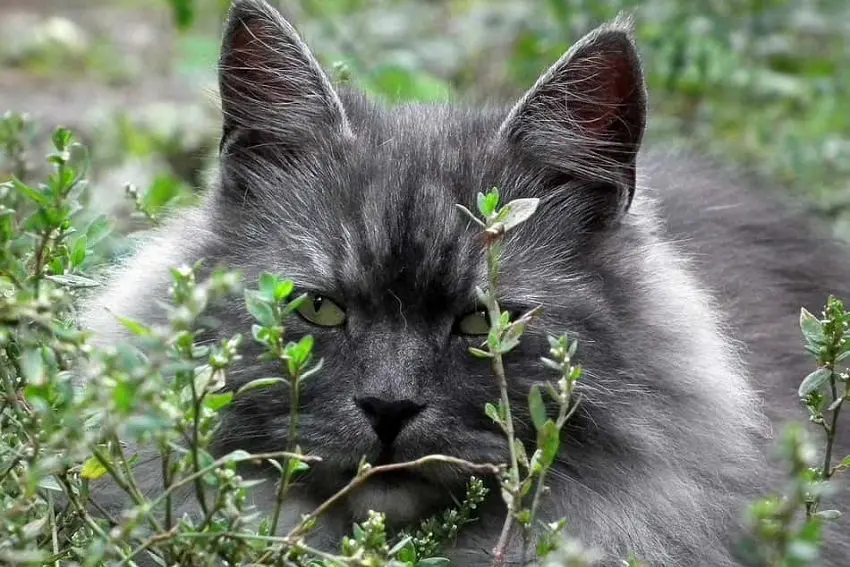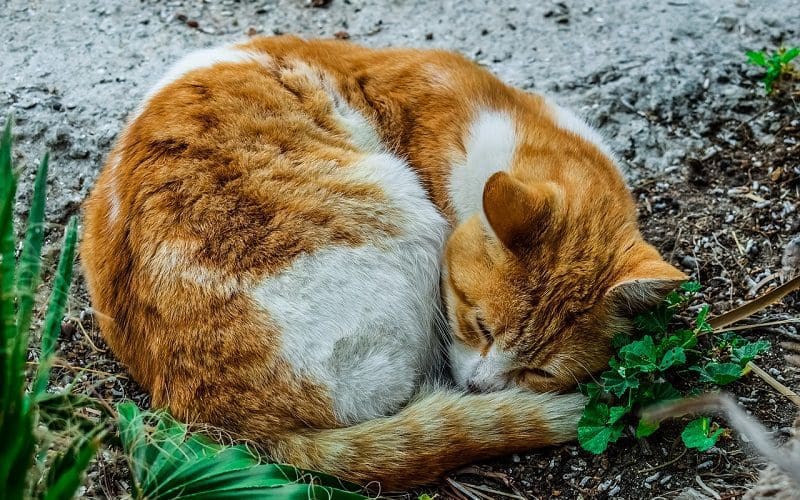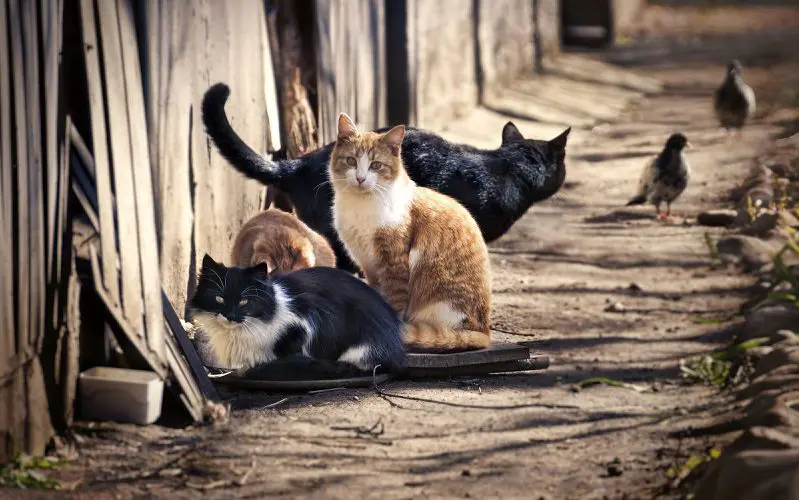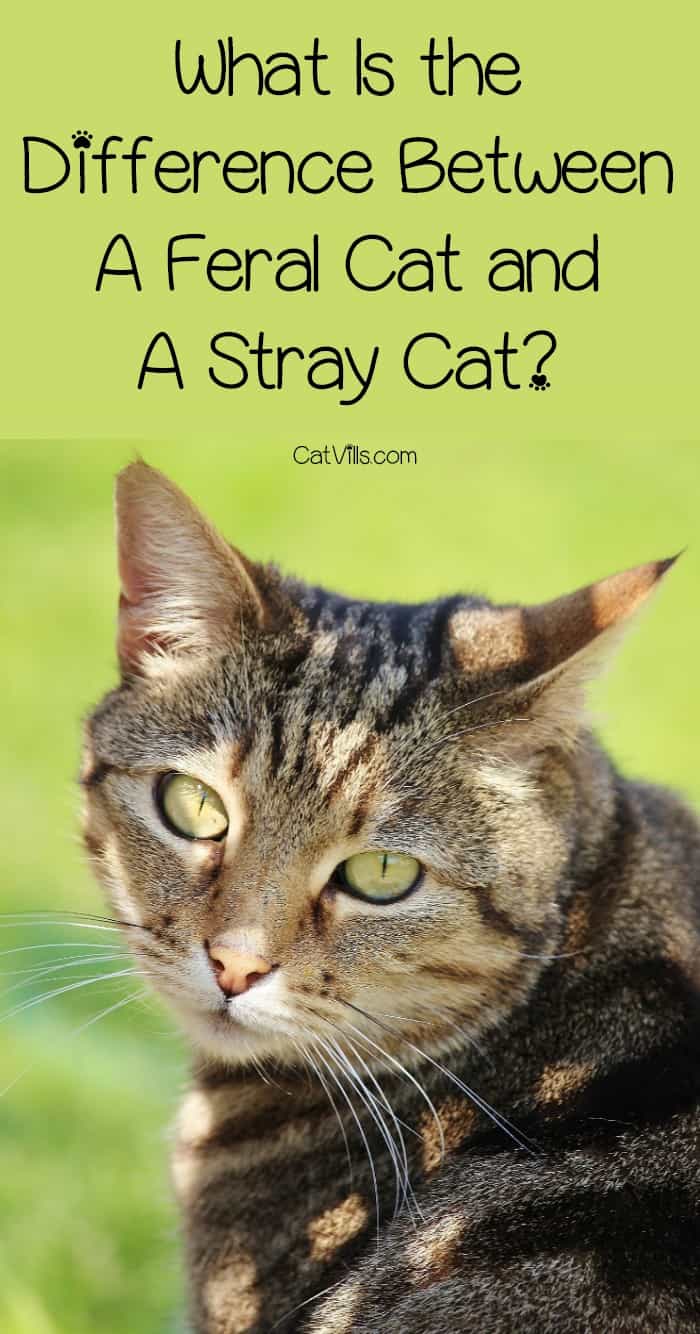Last Updated: 2 years ago
Ever wonder if there’s a difference between stray cats and feral cats?
It seems like there wouldn’t be, right? Both live outside, probably not by choice.
Both deal with issues like hunger, predators, and illnesses that are common in outdoor cats.
So what’s the difference between a feral cat vs stray cat? Are the names interchangeable? Let’s find out!
Difference between stray cats and feral cats

People often confuse feral cats and stray cats because of their seemingly similar natures—both homeless, skittish, and often ragged-looking from fleas and fights—but there are significant differences.
It seems like there wouldn’t be, right? Both live outside, probably not by choice.
Both deal with issues like hunger, predators, and illnesses that are common in outdoor cats.
So what’s the difference? Are the names interchangeable?
Stray Cats 101

Stray cats are ones that started out without a home, and sadly, the shelters are full of them. Stray cats are the ones that have run away, been left behind, been abandoned, or been released.
Strays often vary in behavior based on their history with humans; if a cat has been a beloved house pet, they may still approach humans comfortably.
You may find a stray cat sunning on your back deck, meowing through your screen door at you while you work in your kitchen.
Strays are typically solitary creatures, avoiding other animals through an instinct not to infringe on anyone else’s territory.
It’s also easier to help a sick or injured outdoor cat if you’re dealing with a stray than a feral. A stray cat may respond to an offer of treats or a “here, kitty, kitty”, and can likely be caught relatively easily.
If you catch a stray, first check for a collar or take it to a vet to check for a microchip. With any luck, someone is looking for their lost pet and will be very grateful to hear from you.
How To Tell If A Cat Is Stray
Stray cats are domestic cats that have been abandoned or lost and are currently living outdoors without a permanent home.
They may have had human caregivers before and are typically more accustomed to human contact than feral cats. Here’s how to determine if a cat is a stray:
- Appearance: Stray cats often appear well-groomed, as they have some experience with human care. Their fur may be relatively clean and in good condition. They may wear collars or other signs of previous ownership.
- Behavior: Stray cats might approach humans and show signs of socialization. They may be receptive to human interaction, although they can also be cautious and wary, especially if they’ve had negative experiences.
- Vocalization: Stray cats may meow or vocalize to get the attention of humans. They might try to approach people in search of food, shelter, or affection.
- Scavenging: Stray cats may rely on scavenging for food, such as searching through garbage cans or begging for scraps from people.
- Location: Stray cats are often found in urban or suburban areas, close to human habitation. They may seek shelter in abandoned buildings, under porches, or in sheds.
Feral Cats 101

Feral cats are different. They’ve never had a home with humans, but they don’t live alone either.
Feral cats live in colonies, often with generations of them living together, hunting, fighting, and multiplying rapidly.
These colonies are surprisingly quiet, even the larger ones, because adult cats don’t use meows to communicate with each other; they don’t need verbal communication, and it’s safer if they stay quiet.
In fact, often, cats that come from feral colonies don’t meow even once they are brought into a home.
How To Tell If A Cat Is Feral
They are cats that have had little to no human contact and are primarily wild animals.
They live in a natural state and are generally fearful of humans. Here’s how to determine if a cat is feral:
- Appearance: Feral cats tend to have a more disheveled appearance. Their fur may be dirty, matted, or in poor condition due to alack of grooming.
- Behavior: Feral cats are extremely wary of humans and will typically avoid contact. They are often elusive, darting away when humans approach. They may display aggressive or defensive behavior if cornered.
- Vocalization: Feral cats are generally silent around humans. They do not meow or vocalize to seek attention in the same way that stray or domestic cats might.
- Independence: Feral cats are self-sufficient and rely on hunting for food. They are not reliant on human care or handouts and are skilled at surviving in the wild.
- Location: Feral cats may be found in a variety of environments, including rural areas, forests, and even urban or industrial zones. They often seek secluded locations to avoid human interaction.
It’s important to approach both stray and feral cats with caution. If you’re unsure whether a cat is stray or feral, it’s best to contact a local animal rescue or shelter for guidance on how to proceed, especially if you’re considering providing assistance or trying to help the cat.
Feral Cat vs Stray Cat: Can You Turn Them Into a Pet?
Surprisingly, both feral and stray cats can make great pets, although it will likely take some work, and it is important to know that not all of them will make good pets.
Factors that influence this may be previous experiences with humans—good, bad, or nonexistent—or the age of the cat, among others.
Our Successful Story
I have a little black cat named Loki, who came from a feral colony on a farm in the country.
At only about a week old, my mother rescued him from where he lay in the middle of a dirt road and brought him home, eventually sending him to live with me.
Loki was young enough that he had to be fed milk replacer and weaned off carefully, something that is much easier for a mother cat to do than a human.
He was a sweet boy from the start, though we suspect he had never met a person before he was discovered. He wasn’t old enough to be afraid, and instead he adopted us as his humans immediately.
Loki is the cat that is most likely to be curled on my lap (or keyboard) as I write, holding my hand in his paws as he sleeps (he likes to add a challenge).
Despite his introduction at an extremely young age to my other four cats, he was more than two years old when we first heard him meow (and let me tell you, my other cats are not silent).
He is just over three years old now and is the most playful and affectionate of all of our feline family members—our perma-kitten.
Friends Successful Story
By the same token, friends of ours have a formerly feral cat that they rescued from a large local colony at nearly a year old.
They had another cat, and the initial introduction between the two felines did not go well, to the point where our friends were almost entirely convinced that they would have to find a different home for their new furry little girl.
For weeks, their new cat hid from everyone and everything, and it was several more months before she would make herself visible to strange people.
Now she is a beloved member of their family, and her closest friends are their other cats (oh, and they rescued another feral not long after, who is also right at home these days).
How to Help These Cats

One of the ways that cities manage their feral cat populations is through the “Trap, Neuter, Release,” or TNR, program.
These programs are effective but complicated. Feral cats are trapped, vaccinated, and spayed or neutered.
This ensures that they will not contract or spread illness through the colony and that they will not continue to increase its population. When the cats are fixed and vaccinated, they are also assessed.
Many of the friendlier ones are placed in foster homes or adopted out and make wonderful companions, like Loki and our friends’ cats.
Others are too wild and aggressive to be house cats. These cats are released back into the colony, often with an ear “tipped” so that they don’t get dragged back to the vet’s again if they fall for another trap.
While releasing them back to the colony might seem counter-intuitive, it is often the best choice for cats that cannot be domesticated, in no small part due to the fact that if a feral cat colony is eradicated, another is likely to move into the territory.
If you find yourself with stray or feral cats in your area and are having issues with them, contact your local TNR program or cat rescue for advice; they likely have a network of resources they can draw on to help, and things will go better for you and the cats.
Did you ever bring a stray or feral cat into your home as a pet? Share your experiences below!
Resources:


This is really great info. I’ve definitely met both kinds of cats on the street, and you can almost immediately tell the difference!
I have 5 cats that at one time were strays.They have been the sweetest cats and so loving . I like to take them off the streets before I go to shelters.Their names are Stormy,Raindrop,Little bit who is not so little,Sasha,Princess who over came cancer.
I’ve been taking care of feral colony for 2 years now. We were able to collect kittens from three queens which were taken to a shelter for adoption. Two of the three queens were TNR only one left to captured. I already had 2 rescues at home however I had never tried to foster or socialize a feral kitten. I was able to grab one of the kittens I guess to be about ten + weeks old. Placed it in a large pet carrier which it shook and it tried to destroy so much so it scared one my old girls. I kept it in the carrier overnight but let it out in the morning. Four days later he was jumping into my lap and falling asleep on my stomach. Needless to say Mr Gray became the third kitty in my home. I was really surprised how quickly he socialized I’m sure he’s just special.
Owner of 3 cats, I prefer cats to humans. I have one indoor kitty who picked me 11 years ago when her mama moved her litter into my garage when I wasn’t watching. I helped out by placing a shallow tray of cat litter nearby. After they grew, and I started setting out kitten food for them, one of the 8 would always investigate me first while the other 7 went straight for the food. While I donated the mama and 7 kittens to a local shelter, I chose to keep the one that picked me. The 2nd cat I’d ever owned and the best to date.
Another success story… a visitor asked if she could feed 2 stray cats that walked into my yard, sat and looked at us. That was 10 years ago. Since I was fearful of upsetting my happy home with my indoor kitty, I kept the strays outside, created a heated kitty shelter big enough for the 2 of them. Insulated with 2″ of rigid foam. Raised off the ground. temperature probe so I always knew what the internal temp was of the shelter regulating the temp with one or two heaters. And a frost proof water bowl.
As they age, and more regular trips to the Vet making them officially mine and becoming more of a financial investment, I’m gradually getting them used to being confined in my garage, making sure the litter box is being used and they learn that they have designated bedding, hoping they can make the transition to housecats where they’re safer and more comfortable in their aging years.
My indoor cat sees the two in the garage regularly while I’m going in and out to feed or medicate or visit, seems curious, hisses at any sudden movement by the cats in the garage, while the garage cats stay calm, seems like introductions should go smoothly but all three still have razor sharp claws and don’t want to risk injuries.
As for ferals, I have 3 that stop by and clean out the food bowls I leave for MY cats.
We had a person drop 3 young cats. A male yellow tabby, female grey tabby and a solid grey gender unknown. The male was the sweetest thing. Even though he and the solid grey one went missing shortly after being thrown out of a truck. The yellow tabby after some time showed back up and was missing a eye. And we named him Odin After all he had been through he was still very loving and would come right to you. I had gotten him fixed and had one day before I was bringing him into my home to live ( my female was to be fixed the next day) but it was to late I couldn’t find him and still to this day I look. The female grey tabby had gotten into my house some way and we would see her every now and then. She lived with us for 2 years before she would even come around us. And another year before we could barely touch her and only in our bedroom. Well 6 years has passed and now she sleeps with us. I still miss and look for Odin
So interesting – we are such cat people and this is great information!
Great post!! This is such an informative about Feral cats and stray cats.Thanks for sharing. Will definitely share this to my lovely friends who loves cats
I honestly wouldn’t know the difference since I’m not a cat person. Would share this with my friend who loves cat. Interesting read!
Hi, I’ve been volunteering at an SPCA for over 15 years now. I work with cats, my job is to re-home them to the folks who come to look for a pet. I find that most people who don’t “get into” cats, or actually don’t “like” cats have never really HAD a cat of their very own! They generally come into the shelter with a cat lover, but tend to hang back and not interact with the cats at all. My goal is to overcome the dislike some people have. I’m successful some of the time, too. Firstly, it’s a misconception that all cats are distant, cold and unfriendly. They have the same affection toward us as dogs do, IF it’s a good match of personalities. I think the key to changing a cat hater’s mindset is to understand what his or her expectations are. All cats are NOT alike, they are as different from one another as people are. I often ask the person to just sit in a room with several cats, and surely one will jump up on his or her lap for pets. While under no pressure whatsoever, the person can interact at their own pace and see how sweet and affectionate kitty the really is. Often, a former cat hater leaves the shelter with a new best friend whom they are totally ga-ga over! I love it! If people would just give cats a chance, they may see their true nature and the attraction will begin. It may not happen fast, or maybe not at all, but it’s worth the try because people who are “cat avoiders” are missing out on a very enjoyable experience and a very nice way of life.
Fascinating subject and yes there’s a clear difference between the two. We see a few strays and the occasional ferals in my area.
My wife and I run two separate cat rescues ,Focus on Ferals inc. and Strays Unlimited inc. We do not TNR We TNS trapNeuter socialize ,this is where the real work begins .Very Rewarding ,It touches your Soul , heart and mind.We have been doing this for thirty three years and we’re always learning something new God Bless all of you who care enough to help these poor cats.?
I adopted two sisters with three kittens who were living under our Chicken coop out back. I first trapped the adult cats to have them spade then released them to the back yard. The kittens were next to be caught, spade and released.
I fed them every morning and night on my back steps. I had a beloved Cat of 19 years old in the house. They started to come in the house but I left the door open for their short stays. Eventually I kept them in at night. One night one kitten tried over & over to come in from my window box. She was too scared to do it. I worried all night. In the AM she was dead in the road, run over. I still feel bad. She was the most skiddish and prettiest kitten.
From that day on my Cats stayed in the house. They all lived quite a few years. Only one adult was friendly to me. I would say she and her sister were strays. The kittens were feral.
I adopted a black mother and gray son. Mother was a stray and had been a house cat whereas she was litter box trained. The gray son lets me pet and pick him up. He lives outside. Mom is inside at night. Both are very nice cats. Mom will not let me pick her up yet I can scratch her back.Then there is scaredy cat, a light orange tabby ferral. After two years of feeding this cat, I can now scratch his back when I put his food down to eat. He is sweet, nice to other cats. I feel sorry for him being alone so much. I dearly love these three cats. I have an orange tabby house cat.
How interesting and I am amazed that cats can live outside in the wild and thrive. I never knew any feral cats but I will keep on the lookout for colonies.
I didn’t know any of this. I’m a dog person, but this was super informative! :). My son really wants a cat!
I have a feral that adopted myself and my husband. I would feed on my back deck and she would approach the house and eventually entered my kitchen and slowly walked through our house but on high alert, always turning to see where we were. It took many months but on 8/20/15 she spent the night and my husband enclosed our deck so she has the best of both worlds. She can go out onto the deck yet lives in our house. In 2015 I was feeding 5 feral cats and all went missing within 2 weeks. My Dipper was the lucky one to be saved. So she is not allowed to roam the streets. She is such a good girl and the best part of our family.
I’ve never seen a feral cat where I live. We don’t get many strays either.
That is weird that the feral cat does not meow. I now know more about cats.
My brother took in stray kittens and took care of them. He takes very good care of them and they are now all healthy and very living pets
There is definitely a difference between the two. Back where I use to live there were feral cats around, which wasn’t good since I had a couple cats of my own.
I didn’t realize there was a difference. I seem to encounter more strays then feral.
This is so informative! I never knew the difference between them before. I love cats and I’m so happy to know new information about them!
I always see cats hanging around here and I’ve just always called them stray cats. They could be feral. Good to know the difference.
Our local animal shelter has an exceptional program for feral cats. I don’t mind the ones living around our street so much as one lady gets them fixed and they keep away the snakes and mice…almost wish they would take residence in my back yard!
It’s interesting to know more about these differences! Thanks for sharing it!
Thanks for this post, I learned something new today about a feral cat and stray cat.
I didn’t know that they had different, Thank you for such great information.
I never really thought about the differences. This makes sense! We have two cats that we adopted that were former strays.
Thank you for such great information about these beautiful creatures!
PussPuss came into our lives late July/Early August 2002. He was at our back door, the food we gave him , he would run off with it to eat. After a couple of days, we were able to catch him. Then we were able to give him proper food to eat from a dish. He was not the easiest of cats to live with. We went to get him de-sexed and found out he was younger then we thought. The vet said he was a late June baby, so we gave him my husband birthday as it is easiest to remember. As the years have gone by, he has become less destructive. After having him for five years is when I learnt he repels fleas. so did not worry about anymore. His skin is tough and bent the needle when we had him chipped. Now at 19 years old, he is blind in one eye, has dementia and arthritis, back legs are starting to be less useable, taking medication for his arthritis and thyroid problem and has an open sore that will not heal. Vet is willing to put him down when we are ready. As for if he was a stray or feral who knows. He is reasonably happy apart some noise that sounds like someone is hurting him a couple times a week.